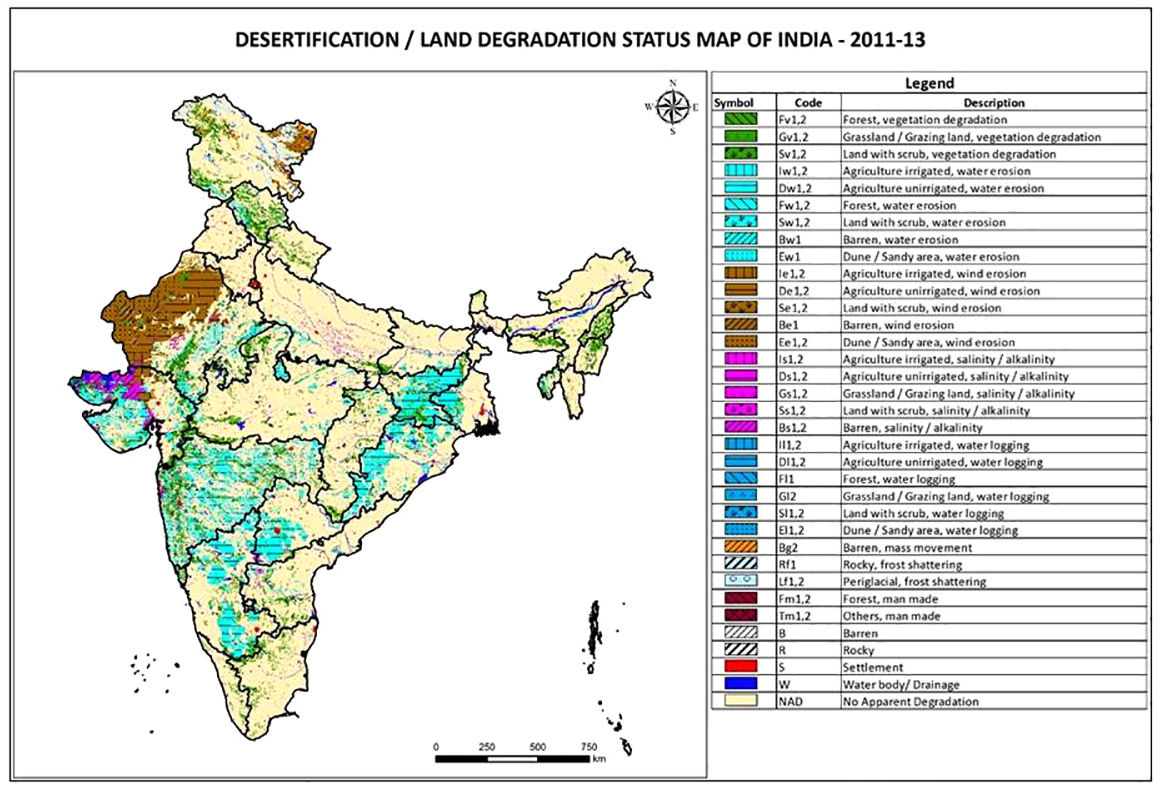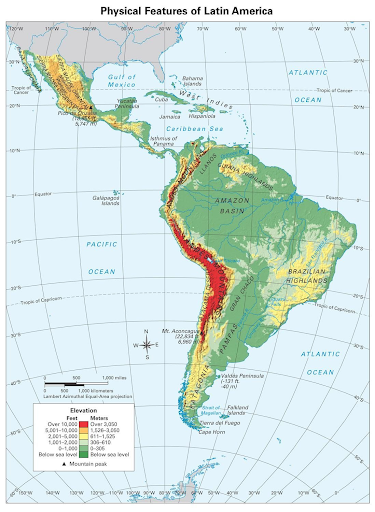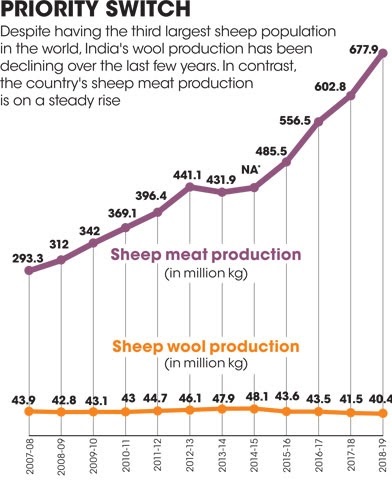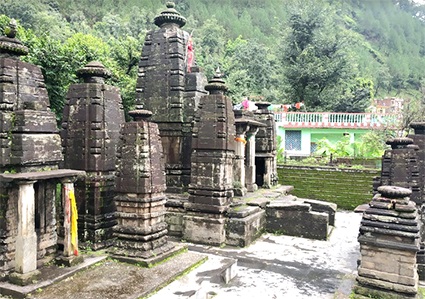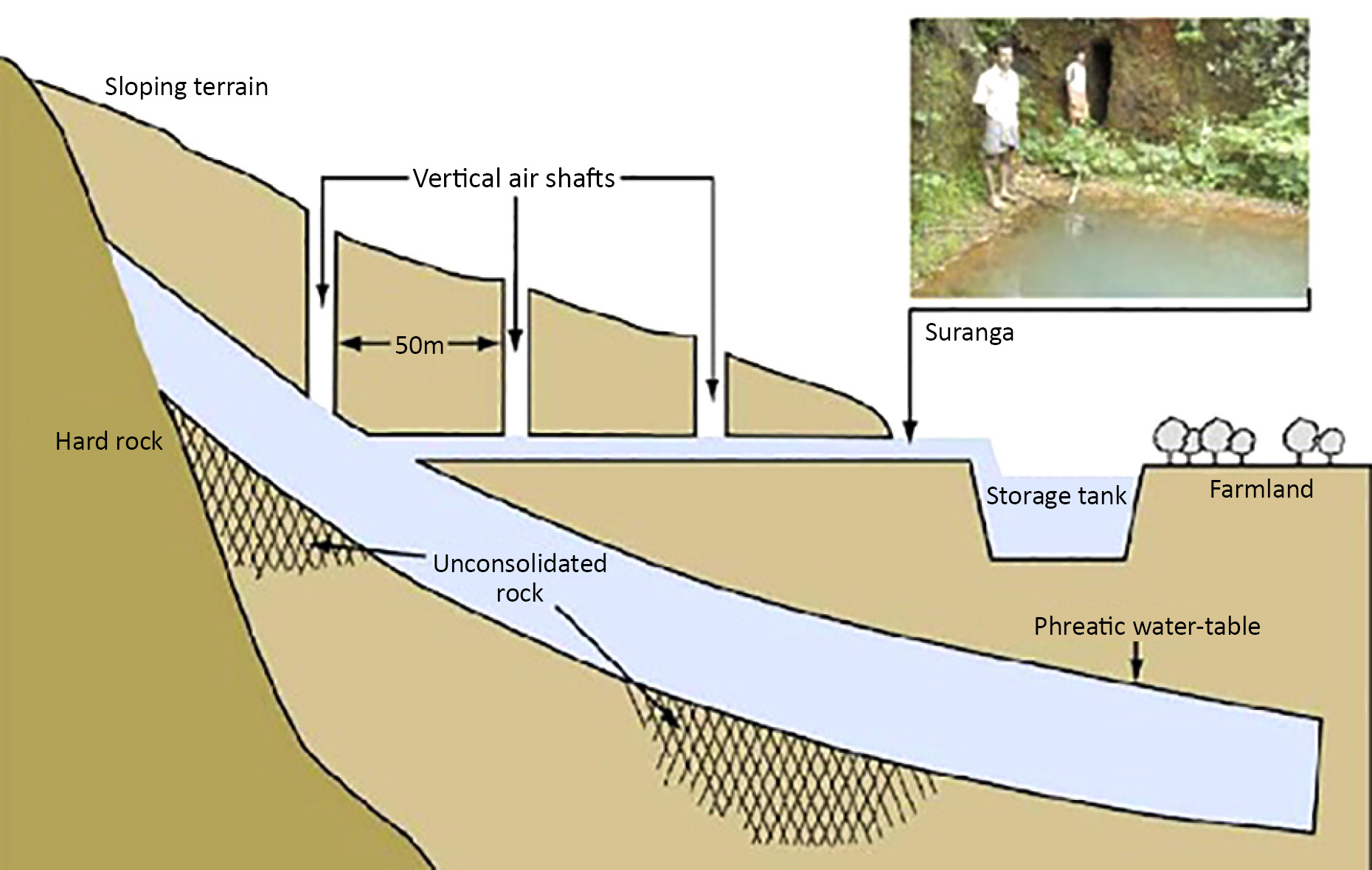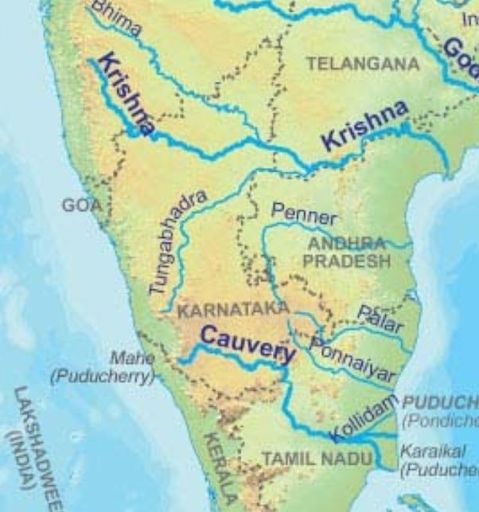Biodiversity & Environment
Land Degradation and Desertification in India
Why in News
Recently, a document published by ISRO (Indian Space Research Organisation) named Desertification and Land Degradation Atlas shows that Land Degradation and Desertification has increased significantly in recent years.
- The Atlas provides a state wise area of degraded lands for the time frame 2018-19. It also provides the change analysis for the duration of 15 years, from 2003-05 to 2018-19.
- Earlier, the Prime Minister delivered a keynote address at the United Nations’ (UN) “High-Level Dialogue on Desertification, Land Degradation and Drought” via video conference.
Key Points
- About:
- Land Degradation:
- Land degradation is caused by multiple forces, including extreme weather conditions, particularly drought. It is also caused by human activities that pollute or degrade the quality of soils and land utility.
- Desertification:
- Land degradation within dry land regions (arid, semi-arid and dry sub-humid regions) is termed as ‘desertification’.
- Desertification is the process by which the biological productivity of drylands is reduced due to natural or manmade factors. It does not mean the expansion of existing deserts.
- Land Degradation:
- Status:
- Land Degradation:
- Some 97.85 million hectares (29.7%) of India’s total geographical area (TGA) of 328.72 mha underwent land degradation during 2018-19.
- In 2003-05, 94.53 mha (28.76% of the TGA) underwent land degradation. The number increased to 96.40 mha (29.32% of the TGA) in 2011-13.
- Desertification:
- Some 83.69 mha underwent desertification in 2018-19. This was greater than the 81.48 mha in 2003-2005 and 82.64 mha in 2011-13 that underwent desertification.
- State wise Data:
- Around 23.79% of the area undergoing desertification / land degradation with respect to TGA of the country was contributed by Rajasthan, Maharashtra, Gujarat, Karnataka, Ladakh, Jharkhand, Odisha, Madhya Pradesh and Telangana.
- India witnessed an increase in the level of desertification in 28 of 31 states and Union territories between 2011-13 and 2018-19, a closer look at data in the atlas showed.
- Land Degradation:
- Causes:
- Loss of Soil Cover:
- Loss of soil cover, mainly due to rainfall and surface runoff, is one of the biggest reasons for desertification. It is responsible for 11.01% of the desertification in the country.
- Cutting forests adversely affect the soil and cause degradation. As urbanization increases, the demand for resources is also increasing.
- Vegetation Degradation:
- Vegetation degradation is defined as, "the temporary or permanent reduction in the density, structure, species composition or productivity of vegetation cover".
- It is found to be responsible for 9.15% of desertification in the country.
- Water Erosion:
- It results in Badland Topography which itself is an initial stage of desertification.
- Badlands are a type of dry terrain where softer sedimentary rocks and clay-rich soils have been extensively eroded.
- In 2011-13, water erosion was responsible for 10.98% of desertification in the country.
- It results in Badland Topography which itself is an initial stage of desertification.
- Wind Erosion:
- Sand encroachment by wind reduces fertility of the soil making the land susceptible to desertification.
- It was found to be responsible for 5.46% of the desertification in India.
- Climate Change:
- It may exacerbate desertification through alteration of spatial and temporal patterns in temperature, rainfall, solar radiation and winds.
- Loss of Soil Cover:
- Impact:
- Economic Impact:
- Land degradation threatens agricultural productivity. It reduces soil health, thus in turn impacting the livelihood of rural people.
- Climate Change:
- It is exacerbating climate change events, which in turn, are causing even greater degradation.
- For e.g. degraded land loses its capacity to absorb carbon-dioxide (CO2), a greenhouse gas (GHG) that is the biggest factor in worsening global warming.
- It is exacerbating climate change events, which in turn, are causing even greater degradation.
- Water Scarcity:
- Land degradation has resulted in a deterioration in the quantity and quality of both surface and groundwater resources.
- The dryland population vulnerable to water stress and drought intensity is projected to reach 178 million under the most ideal conditions of 1.5 deg-C warming by 2050.
- Rights of Indigenous People:
- Insecure land tenure affects the ability of people and communities to fight climate change, which is further endangered by land degradation.
- Economic Impact:
- Measures taken by India to Curb Desertification/Land Degradation:
- Integrated Watershed Management Programme:
- It aims to restore ecological balance by harnessing, conserving and developing degraded natural resources with the creation of Rural Employment. Now it is subsumed under Pradhan Mantri Krishi Sinchai Yojana which is being implemented by NITI Ayog.
- Desert Development Programme:
- It was launched in 1995 to minimize the adverse effect of drought and to rejuvenate the natural resource base of the identified desert areas.
- It was launched for hot desert areas of Rajasthan, Gujarat, Haryana and cold desert areas of Jammu & Kashmir and Himachal Pradesh.
- United Nations Convention to Combat Desertification (UNCCD):
- India became a signatory to the UNCCD in 1994 and ratified in 1996. India is working to restore 26 million hectares of degraded land by 2030.
- India is working hard to achieve its national commitment on Land Degradation Neutrality (LDN) (Sustainable Development Goal target 15.3).
- LDN is a state whereby the amount and quality of land resources, necessary to support ecosystem functions and services and enhance food security, remains stable or increases within specified temporal and spatial scales and Ecosystems.
- National Afforestation Programme:
- It has been implemented since 2000 for the afforestation of degraded forest lands. It is being implemented by the Ministry of Environment, Forest and Climate Change
- National Action Programme to Combat Desertification:
- It was prepared in 2001 to address issues of increasing desertification and to take appropriate actions.
- National Mission on Green India:
- It was approved in 2014 with the objective of protecting, restoring and enhancing India’s diminishing forest cover with a deadline of 10 years.
- Integrated Watershed Management Programme:
Biodiversity & Environment
State of the Climate on Latin America and the Caribbean 2020: WMO
Why in News
Recently, the World Meteorological Organization (WMO) has released a report on the impacts of climate change and extreme weather in Latin America and the Caribbean.
- 2020 was a year of unprecedented heatwaves, droughts, forest fires, cyclones and food insecurity for the region.
- The Intergovernmental Panel on Climate Change in its sixth assessment report had highlighted the impact of climate change on the Indian Subcontinent.
World Meteorological Organization
- About:
- It is an intergovernmental organization with a membership of 192 Member States and Territories. India is a member.
- It originated from the International Meteorological Organization (IMO), which was established after the 1873 Vienna International Meteorological Congress.
- Establishment:
- Established by the ratification of the WMO Convention on 23rd March 1950, WMO became the specialized agency of the United Nations for meteorology (weather and climate), operational hydrology and related geophysical sciences.
- Headquarters:
- Geneva, Switzerland.
- Reports released by WMO:
- State of the Global Climate
- Greenhouse Gas Bulletin
Key Points
- Rise in Temperature:
- 2020 was among the three warmest years in Central America and the Caribbean and the second warmest year in South America.
- Sea surface temperature in the Tropical North Atlantic Ocean was significantly warmer than normal throughout the year.
- Severe heat waves dominated the region through most of the year, with temperatures soaring above 40°C several days in a row.
- Intense Rainfall:
- Intense rainfall resulted in landslides, floods and flash floods in the rural as well as urban areas of Central and South America towards the end of 2020.
- Forest Fires and Cyclones:
- Deforestation has only increased in the last four years due to clearing for cattle pasture and degradation from fires.
- Deforestation in the Amazon River Basin, which stretches across nine countries in South America and stores 10% of global carbon, has already led to a decline in its ability to regulate climate.
- The Atlantic basin recorded as many as 30 cyclones in 2020 — the highest so far in a single year.
- Deforestation has only increased in the last four years due to clearing for cattle pasture and degradation from fires.
- Impact:
- Extreme weather events affected over 8 million people across Central America, exacerbating food insecurity in countries already crippled by economic shocks, Covid-19 restrictions, and conflict.
- Suggestions:
- Hazard-specific monitoring systems such as FAO's Agricultural Stress Index System (ASIS) is an example of a useful tool to allow governments to issue early warning alerts for specific sectors like agriculture.
- Develop Early Warning Systems (EWS) and contingency plans.
- Early warning systems were underdeveloped in the region, particularly in South America.
- Planting of the mangroves, an ecosystem of which can help sequester three-four times more carbon than most forests.
- Area under mangrove plantation declined 20% between 2001 and 2018 in the region.
- Greater political commitment and more financial support is needed to strengthen EWS and operational weather, climate and hydrological services to support risk management and adaptation.
Latin America and Caribbean (LAC) Region
- About:
- Latin America is generally understood to consist of the entire continent of South America in addition to Mexico, Central America, and the islands of the Caribbean.
- It encompasses 33 countries.
- Geographical Features:
- Amazon River, Caribbean Sea, Gulf of Mexico, Pacific Ocean, Panama Canal, Andes Mountains, Sierra Madre Mountains, and Atacama Desert.
- Major Economic Blocs:
- MERCOSUR: The Southern Common Market consists of five countries in southern Latin America: Argentina, Brazil, Paraguay, Uruguay and Venezuela.
- CARICOM: The Caribbean Community consisting of 19 island groups: Antigua and Barbuda, the Bahamas, Barbados, Belize, Dominica, Grenada, Guyana, Haiti, Jamaica, Montserrat, St. Kitts and Nevis, Saint Lucia, St. Vincent and the Grenadines, Suriname, and Trinidad and Tobago.
- CAN: The Andean Community consists of four countries: Bolivia, Colombia, Ecuador and Peru.
- SICA: The Central American Integration System consisting of seven countries: Belize, Guatemala, El Salvador, Honduras, Nicaragua, Costa Rica and Panama.
Indian Polity
Reservation Applicable in Either of States after Division: SC
Why in News
Recently, the Supreme Court (SC) has ruled that a person belonging to a reserved category in an undivided state is entitled to claim benefit of reservation in either of the successor States.
- The ruling came after a resident (Scheduled Caste) of Jharkhand, filed an appeal against the High Court order denying him appointment in state civil service examination of 2007 on the ground that his address proof showed that he was a permanent resident of Patna, Bihar.
- Under the Bihar Reorganisation Act, 2000 passed by the parliament a new state, Jharkhand was created from a portion of Bihar.
- Article 3 empowers the Parliament to make law relating to the formation of new states and alteration of existing states.
Key Points
- Reservation:
- The SC has ruled that a person belonging to a reserved category is entitled to claim benefit of reservation in either of the successor States of Bihar or Jharkhand.
- However he/she cannot claim benefit of the quota simultaneously in both the successor States upon their reorganisation in November, 2000. As it will defeat the mandate of Articles 341(1) and 342(1) of the Constitution.
- Article 341: The President may with respect to any State or Union territory, and where it is a State after consultation with the Governor thereof, by public notification, specify the castes, races or tribes or parts of or groups within castes, races or tribes which shall for the purposes of this Constitution be deemed to be Scheduled Castes in relation to that State or Union territory, as the case may be.
- Article 342: The President may with respect to any State or Union territory, and where it is a State, after consultation with the Governor thereof, by public notification, specify the tribes or tribal communities or parts of or groups within tribes or tribal communities which shall for the purposes of this Constitution be deemed to be Scheduled Tribes(ST) in relation to that State or Union territory, as the case may be
- Other State Migrants:
- Members of the reserved category, who are residents of the successor State of Bihar, while participating in open selection in Jharkhand shall be treated to be migrants and they can participate in the general category without claiming the benefit of reservation and vice-versa.
Constitutional Provisions Governing Reservation in India
- Part XVI deals with reservation of SC and ST in Central and State legislatures.
- Article 15(4) and 16(4) of the Constitution enabled the State and Central Governments to reserve seats in government services for the members of the SC and ST.
- The Constitution was amended by the Constitution (77th Amendment) Act, 1995 and a new clause (4A) was inserted in Article 16 to enable the government to provide reservation in promotion.
- Later, clause (4A) was modified by the Constitution (85th Amendment) Act, 2001 to provide consequential seniority to SC and ST candidates promoted by giving reservation.
- Constitutional 81st Amendment Act, 2000 inserted Article 16 (4 B) which enables the state to fill the unfilled vacancies of a year which are reserved for SCs/STs in the succeeding year, thereby nullifying the ceiling of fifty percent reservation on total number of vacancies of that year.
- Article 330 and 332 provides for specific representation through reservation of seats for SCs and STs in the Parliament and in the State Legislative Assemblies respectively.
- Article 243D provides reservation of seats for SCs and STs in every Panchayat.
- Article 233T provides reservation of seats for SCs and STs in every Municipality.
- Article 335 of the constitution says that the claims of STs and STs shall be taken into consideration constituently with the maintenance of efficacy of the administration.
- The 103rd Constitution Amendment Act, 2019, empowered both Centre and the states to provide 10% reservation to the EWS (Economically Weaker Section) category of society in government jobs and education institutions.
Governance
Defence India Start-up Challenge 5.0
Why in News
Recently, the Ministry of Defence launched the 5th edition of the Defence India Start-up Challenge (DISC) under Innovations for Defence Excellence - Defence Innovation Organisation (iDEX-DIO).
- Thirty-five problem statements – 13 from the Services and 22 from Defence Public Sector Undertakings (DPSUs) – were unveiled under DISC 5.0. Some of which are:
- Situational awareness, augmented reality, Artificial Intelligence, aircraft-trainer, non-lethal devices, 5G network, Underwater Domain Awareness, Drone SWARMS and data capturing.
Innovation for Defence Ecosystem (iDEX)
- About:
- It was launched in 2018, as an ecosystem to foster innovation & technology development in Defence and Aerospace by engaging innovators & entrepreneurs to deliver technologically advanced solutions for modernizing the Indian Military.
- It provides funding/grants to MSMEs, start-ups, individual innovators, R&D institutes and academia to carry out research and development.
- iDEX is funded and managed by “Defence Innovation Organisation”.
- Core Objectives:
- Indigenization: Rapid development of new, indigenized and innovative technology.
- Innovation: Creates a culture of engagement with innovative startups to encourage co-creation.
Key Points
- About:
- DISC aims at supporting Startups/MSMEs (Micro Small and medium Enterprises)/Innovators to create prototypes and/or commercialize products/solutions in the area of National Defence and Security.
- It is meant to achieve self-reliance and foster innovation and technology development in the defence and aerospace sectors.
- It was launched by the Ministry of Defence in partnership with Atal Innovation Mission.
- Under the program, the start-ups, Indian companies and individual innovators (including research & academic institutions) can participate.
- DISC 5.0 will be a massive leap towards leveraging the startup ecosystem to develop India's defence technologies, equipment design and manufacturing capabilities.
- Vision:
- Prototyping: Help create functional prototypes of products/technologies relevant for national security, and spur fast-moving innovation in the Indian defence sector.
- Commercialization: Help new tech products/technologies find a market and early customer in the form of the Indian Defence Establishment.
- Significance:
- It forms a link between youth, academia, R&D, start-ups and the armed forces.
- These challenges will also encourage startups to become more attuned to innovative concepts and inculcate the approach of creative thinking in India's budding entrepreneurs.
Indigenisation of Defence Sector
- About:
- Indigenisation is the capability of developing and producing any defence equipment within the country for the dual purpose of achieving Self Reliance and reducing the burden of imports.
- Self-reliance in defence manufacturing is one of the key objectives of Department of Defence Production.
- Defence Research Development Organisation (DRDO), Defence Public Sector Undertakings (DPSUs), Ordnance Factory Board (OFB) and private organisations are playing a critical role in indigenisation of defence industries.
- The defence ministry has set a goal of a turnover of USD 25 billion in defence manufacturing by 2025 that included an export target of USD 5 billion worth of military hardware.
- Indigenisation is the capability of developing and producing any defence equipment within the country for the dual purpose of achieving Self Reliance and reducing the burden of imports.
- Need of Indigenisation:
- Reducing Fiscal Deficit:
- India is the second largest arms importer in the world (after Saudi Arabia).
- Higher import dependency leads to an increase in the Fiscal Deficit.
- Security Imperative:
- Indigenisation is critical to National Security also.
- It keeps intact the technological expertise and encourages spin-off technologies and innovation that often stem from it.
- Employment generation:
- Defence manufacturing will lead to the generation of satellites industries that in turn will pave the way for generation of employment opportunities.
- Strategic Capability:
- Self sufficient and self-reliant defence industry will place India among the top global powers.
- Nationalism and Patriotism can increase with indegenious production of defence equipment, that in turn will not only boost the trust and confidence of the Indian forces but will also strengthen a sense of integrity and sovereignty in them.
- Reducing Fiscal Deficit:
- Challenges to Indigenisation of Defence Sector:
- Lack of Private participation:
- The defence manufacturing has been dependent on DRDO & Defence PSUs only.
- The participation of the private sector has been allowed only recently.
- Lack of expertise:
- In the Navy only, the naval architects were recruited from IITs & were provided training in foreign countries.
- However, the army & air force does not have such a capacity building programme.
- Hurdles in manufacturing:
- Bureaucratic hurdles, Political hurdles, Shortage of human & technical resources, Lack of timely delivery.
- Inefficient budgeting:
- Most of the defence budget goes towards salaries, perks & maintenance of equipment.
- Corruption:
- Arms sales & lobbying reduced efficiency and effectiveness of defence spending.
- Lack of Coordination:
- Lack of coordination between academia, military & industry and poor R&D due to lack of government funding and poor industry-academia collaboration.
- Lack of Private participation:
- Other Related Initiatives:
- First Negative Indigenisation:
- In august 2020, the government announced that India will stop the import of 101 weapons and military platforms like transport aircraft, light combat helicopters, conventional submarines, cruise missiles and sonar systems by 2024.
- Positive Indigenisation List:
- It places import restrictions on 108 military weapons and systems such as next-generation corvettes, airborne early warning systems, tank engines and radars.
- It is planned to be implemented progressively with effect from December 2021 to December 2025.
- New FDI Policy in Defence Sector:
- In May 2020, the government announced increasing the Foreign Direct Investment limit from 49 % to 74 % under the automatic route in the defence sector.
- Defence Acquisition Procedure 2020:
- It contains policies and procedures for procurement and acquisition from the capital budget of the Ministry of Defence in order to modernise the Armed Forces including the Coast Guard.
- Defence Industrial Corridors:
- The defence corridors will facilitate a well-planned and efficient industrial base that will lead to increased defence production in the country.
- First Negative Indigenisation:
Way Forward
- Private Sector boost is necessary as it can infuse efficient and effective technology and human capital required for modernisation of indegenious defence industry.
- In⎯house design capability should be improved amongst the three services, the Navy has progressed well on the path of indigenisation primarily because of the in⎯house design capability, the Naval Design Bureau.
- The government can provide an autonomous status to DRDO which will improve the number of sub-contracts to the private sector and also instil confidence to private sectors.
Indian Economy
India’s Wool Sector
Why in News
Amid the rising demand of import of wool, shepherds in Uttarakhand will get a batch of lambs through crossbreeding of sheep indigenous to the region with Australian Merino sheep by the end of the year.
- Australian Merino sheep are known to have the softest and finest wool used for apparels.
- The main trigger for import was the deteriorating quality and quantity of carpet and apparel grades wool, largely due to inbreeding.
Key Points
- About:
- India is the seventh-largest producer of wool and accounts for nearly 2 to 3% of total world production.
- India has the third largest sheep population in the world with over 64 million sheep. The annual wool production is in the range of 43-46 million kg.
- Due to the insufficient domestic production, India depends on imports for raw wool, particularly on Australia and New Zealand.
- This wool is then used to prepare products like carpets, yarn, fabrics and garments for the domestic market and for exporting, especially to the United States and Europe.
- Rajasthan is the largest wool producer and is known for its superior carpet grade Chokla and Magra wool.
- Carpet grade is rougher than apparel grade and accounts for 85% of India’s production.
- Apparel grade wool accounts for less than 5% of production and coarse grade fit for making rough blankets accounts for the rest.
- Significance:
- The wool textile industry provides employment to 2.7 million workers - 1.2 million in the organised sector, 1.2 million in sheep rearing and farming, and 0.3 million weavers in the carpet sector.
- Challenges:
- Fall in use of Indigenous Wool:
- In the 10 years till 2020, wool consumption by the country’s processing units increased by 50%, but the use of indigenous wool fell to almost 10% of the total current sales in Bikaner (Rajasthan).
- Decrease in Pastures:
- Pastures are diminishing across the country with the increase in plantations as well as urbanisation.
- In Rajasthan, grazing land fell from 1.7 million hectares (ha) in 2007-08 to 1.6 million ha in 2017-18, according to state agriculture department data.
- Pastures are diminishing across the country with the increase in plantations as well as urbanisation.
- Shift in Farmers focus:
- Farmers’ focus has shifted from wool to meat.
- Telangana promotes the meat-producing Nellore breed through a subsidised sheep distribution scheme and the breed now comprises 51% of the state’s sheep.
- Farmers’ focus has shifted from wool to meat.
- Others:
- Outdated and inadequate pre- and post-loom processing facilities.
- Ineffective role of state wool marketing organisations.
- Lack of a Minimum Support Price (MSP) system.
- No educational institute for wool technology.
- Fall in use of Indigenous Wool:
- Government Initiative:
- For the holistic growth of the wool sector, Ministry of Textiles, formulated an integrated programme i.e. Integrated Wool Development Programme (IWDP).
Way Forward
- Since most shepherds in the country rear sheep not by choice, but due to the lack of other options or because it is their traditional practice. So, there is a need to make this sector lucrative by raising awareness, improving access to pasture lands, facilitating marketing of wool, offering remunerative prices, and upgrading the supply chain for herders who are on the bottom rung of the ladder.
Governance
PM-KUSUM and Rooftop Solar Programme Phase-II
Why in News
Recently, the Ministry of New and Renewable (MNRE) has conducted a review of implementation of Prime Minister’s Kisan Urja Suraksha Evam Utthan Mahabhiyan (PM-KUSUM) scheme and Rooftop Solar Programme Phase-II and suggested measures for expansion of the schemes.
Key Points
- About PM-KUSUM:
- The PM-KUSUM scheme was launched by the MNRE in 2019, to support installation of off-grid solar pumps in rural areas and reduce dependence on grid, in grid-connected areas.
- The objective of the scheme is to enable farmers to set up solar power generation capacity on their barren lands and to sell it to the grid.
- The government’s Budget for 2020-21 expanded the scope for the scheme with 20 lakh farmers to be provided assistance to install standalone solar pumps; another 15 lakh farmers to be given help to solarise their grid-connected pump sets.
- Intended Benefits of the PM- KUSUM Scheme:
- Helping Farmers:
- It ensures water-security to farmers by providing a day-time reliable source of power for irrigation activities.
- It also incentivises the farmers to sell surplus solar energy to the states, which in turn will augment their income.
- Helping Environment:
- If farmers are able to sell surplus power, they will be incentivised to save power and, in turn, it will mean the reasonable and efficient use of groundwater.
- Also, expansion of the irrigation cover by providing decentralized solar-based irrigation and moving away from polluting diesel.
- Helping Discoms:
- As farmers will be less dependent on subsidized electricity, the PM KUSUM scheme will support the financial health of electricity distribution companies (discoms) by reducing the burden of subsidy to the agriculture sector.
- Help them meet the RPO (Renewable Purchase Obligation) targets.
- Helping States:
- Promotes decentralised solar power production, and reduces transmission losses.
- A potential way to reduce their subsidy outlay towards irrigation.
- Helping Farmers:
- About Rooftop Solar Programme Phase II:
- The aim is to achieve a cumulative capacity of 40,000 MW from Rooftop Solar Projects by the year 2022.
- In a grid-connected rooftop or small Solar Voltaic Panel system, the DC power generated from the Solar Voltaic panel is converted to AC power using the power conditioning unit and is fed to the grid.
- This scheme is being implemented in the states by distribution companies (DISCOMs).
- The MNRE is providing a 40% subsidy for the first 3 kW and 20% subsidy beyond 3 kW and upto 10 kW of solar panel capacity.
- Objectives of the Rooftop Solar Programme:
- To promote the grid-connected SPV rooftop and small SPV power generating plants among the residential, community, institutional, industrial and commercial establishments.
- To mitigate the dependence on fossil fuel based electricity generation and encourage environment-friendly Solar electricity generation.
- To create an enabling environment for investment in the solar energy sector by the private sector, state government and the individuals.
- To create an enabling environment for the supply of solar power from rooftop and small plants to the grid.
- Therefore, the installation of rooftop solar will bring down the electricity consumption of the households and save electricity expenditure.
Other Schemes for Promoting Solar Energy
- Scheme for Development of Ultra Mega Renewable Energy Power Parks: It is a scheme to develop Ultra Mega Renewable Energy Power Parks (UMREPPs) under the existing Solar Park Scheme.
- National Wind-Solar Hybrid Policy 2018: The main objective of the Policy is to provide a framework for promotion of large grid connected wind-solar PV hybrid systems for optimal and efficient utilization of wind and solar resources, transmission infrastructure and land.
- Atal Jyoti Yojana: The AJAY scheme was launched in September 2016 for the installation of solar street lighting (SSL) systems in states with less than 50% households covered with grid power (as per Census 2011).
- International Solar Alliance (ISA): The ISA, is an Indian initiative that was launched by the Prime Minister of India and the President of France on 30th November 2015 in Paris, France on the side-lines of the Conference of the Parties (COP-21), with 121 solar resource rich countries lying fully or partially between the tropic of Cancer and tropic of Capricorn as prospective members.
- One Sun, One World, One Grid (OSOWOG): It focuses on a framework for facilitating global cooperation, building a global ecosystem of interconnected renewable energy resources (mainly solar energy) that can be seamlessly shared.
- National Solar Mission: It is a part of the National Action Plan on Climate Change.
- Suryamitra Skill Development Programme: To provide skill training to rural youth in handling solar installations.
Important Facts For Prelims
Uttarakhand’s Narayankoti Temple: Adopt a Heritage Project
Why in News
Recently, the Narayankoti temple (Uttarakhand) has been included under the Centre's Adopt a Heritage project.
Key Points
- Adopt a Heritage Project:
- About:
- Launched on 27th September, 2017 (World Tourism Day), it is a collaborative effort by the Ministry of Tourism, Ministry of Culture and Archaeological Survey of India (ASI), State/UTs Governments.
- Aim:
- To develop tourism amenities at heritage/ natural/ tourist sites spread across India to make them tourist friendly, in a planned and phased manner.
- Implementation:
- The sites/monuments are selected on the basis of tourist footfall and visibility and can be adopted by private and public sector companies and individuals — known as Monument Mitras — for an initial period of five years.
- The Monument Mitras are selected by the ‘oversight and vision committee,’ co-chaired by the Tourism Secretary and the Culture Secretary, on the basis of the bidder’s ‘vision’ for development of all amenities at the heritage site.
- There is no financial bid involved.
- The corporate sector is expected to use Corporate Social Responsibility (CSR) funds for the upkeep of the site.
- About:
Other Related Schemes
- Narayankoti Temple:
- The temple is a group of ancient temples, about 2 km from Guptkashi on the Rudraprayag-Gaurikund highway.
- This is the only place in the country which has nine planetary temples in a group that are a “symbol of nine planets”.
- It is devoted to Lakshmi Narayana who is associated with Pandavas.
- It is believed that these temples were constructed in the 9th century.
Other Important Places in Uttarakhand
- Chardham - Gangotri, Yamunotri, Badrinath (on the bank of River Alaknanda, dedicated to Lord Vishnu), Kedarnath (dedicated to Lord Shiva), collectively known as Char dham.
- Under the Chardham Pariyojana, the Ministry of Road Transport and Highways is aiming to improve the connectivity for Chardham.
- Hemkund Sahib: Formerly known as Gurudwara Shri Hemkund Sahib Ji, it is a Sikh place of worship and pilgrimage site in Chamoli district. It is devoted to Guru Gobind Singh, the tenth Sikh Guru, and finds mention in Dasam Granth, a work dictated by Guruji himself.
- UNESCO World Heritage Site of Valley of Flowers and Nanda Devi (National Parks).
- Jim Corbett National Park (oldest national park of the country) and Rajaji Tiger Reserve.
Important Facts For Prelims
Surangam System
Why in News
The Karez System of Afghanistan is in threat whereas a similar system named Surangam in South India is thriving.
- Surangams resemble the karez System both in structure and spread.
Key Points
- About Surangams:
- The surangam or suranga is usually found in northern Kerala and southern Karnataka.
- Surangam is basically a tunnel dug through a laterite hillock from the periphery of which water and moisture seeps out.
- Surangams are similar to Qanats which once existed in Mesopotamia and Babylon around 700 Before Common Era (BCE). By 714 BCE, this technology had spread to Egypt, Persia and India.
- Qanats are underground tunnel systems that bring infiltrated groundwater, surface water, or spring water to the earth's surface using only gravitational force.
- This system has been very effectively used for domestic and agriculture purposes in dry areas of northern Malabar.
- Some people believe the surangam is indigenous and a likely origin of the suranga system refers to 18 Karhada Brahmin families that had been moved to the Kasargod area from modern-day Maharashtra in the 17th century under duress.
- Karez System:
- The karez system is a legacy of its Persian cultural moorings. It has suffered extensive damage in 43 years of war and stares at an uncertain future under the Taliban’s second regime.
- Karez is a water harnessing technology in which groundwater is brought to the surface by a tunnel.
- In this system, no mechanical pump or lift is used. Gravity alone brings the water from the underground source.
- The technology originated in Persia/Iran and was widely used during the medieval period.
| Sr. No | Ecological Region | Traditional Water Management System |
| 1. | Trans - Himalayan Region | Zing |
| 2. | Western Himalaya | Kul, Naula, Kuhl, Khatri |
| 3. | Eastern Himalaya | Apatani |
| 4. | North Eastern Hill Ranges | Zabo |
| 5. | Brahmaputra Valley | Dongs / Dungs/ Jampois |
| 6. | Indo-Gangetic Plains | Ahars – Pynes, Bengal’s Inundation Channels, Dighis, Baolis |
| 7. | The Thar Desert | Kunds, Kuis/beris, Baoris / Ber/ Jhalaras, Nadi, Tobas, Tankas, Khandins, Vav/Bavadi, Virdas, Paar |
| 8. | Central Highlands | Talab, Bandhis, Saza Kuva, Johads, Naada/Bandh, Pat, Rapat, Chandela Tank, Bundela Tank |
| 9. | Eastern Highlands | Katas / Mundas / Bandhas |
| 10. | Deccan Plateau | Cheruvu, Kohli Tanks, Bhandaras, Phad, Kere, The Ramtek Model |
| 11. | Western Ghats | Surangam |
| 12. | West Coastal Plains | Virdas |
| 13. | Eastern Ghats | Korambu |
| 14. | Eastern Coastal Plains | Eri / Ooranis |
| 15. | The Islands | Jack Wells |
Important Facts For Prelims
Tungabhadra Dam
Why in News
Recently, the Vice President visited the Tungabhadra dam in Karnataka.
Key Point
- About:
- Tungabhadra dam also known as Pampa Sagar is a multipurpose dam built across Tungabhadra River in Hosapete, Ballari district of Karnataka. It was built by Dr. Thirumalai Iyengar in 1953.
- Tungabhadra reservoir has a storage capacity of 101 TMC (Thousand Million Cubic feet) with catchment area spreading to 28000 square kms. It is about 49.5 meters in height.
- Importance:
- It is the life-line of 6 chronically drought prone districts of Bellary, Koppal and Raichur in Karnataka (popularly known as the rice bowl of Karnataka) and Anantapur, Cuddapah and Kurnool in neighbouring Andhra Pradesh.
- Besides irrigating vast patches of land in the two states, it also generates hydel power and helps prevent floods.
- It is a sacred river in southern India that flows through the state of Karnataka to Andhra Pradesh. The ancient name of the river was Pampa. The river is approximately 710 km long, and it drains an area of 72,200 sq km.
- It is formed by the confluence of two rivers, the Tunga River and the Bhadra River. Both Tunga & Bhadra Rivers originate on the eastern slopes of the Western Ghats.
- The greater part of the Tungabhadra’s course lies in the southern part of the Deccan plateau. The river is fed mainly by rain, and it has a monsoonal regimen with summer high water.
- It’s Major tributaries are the Bhadra, the Haridra, the Vedavati, the Tunga, the Varda and the Kumdavathi.
- It flows in a more or less northwest direction before joining the eastern river Krishna. The Krishna River finally ends into the Bay of Bengal.

